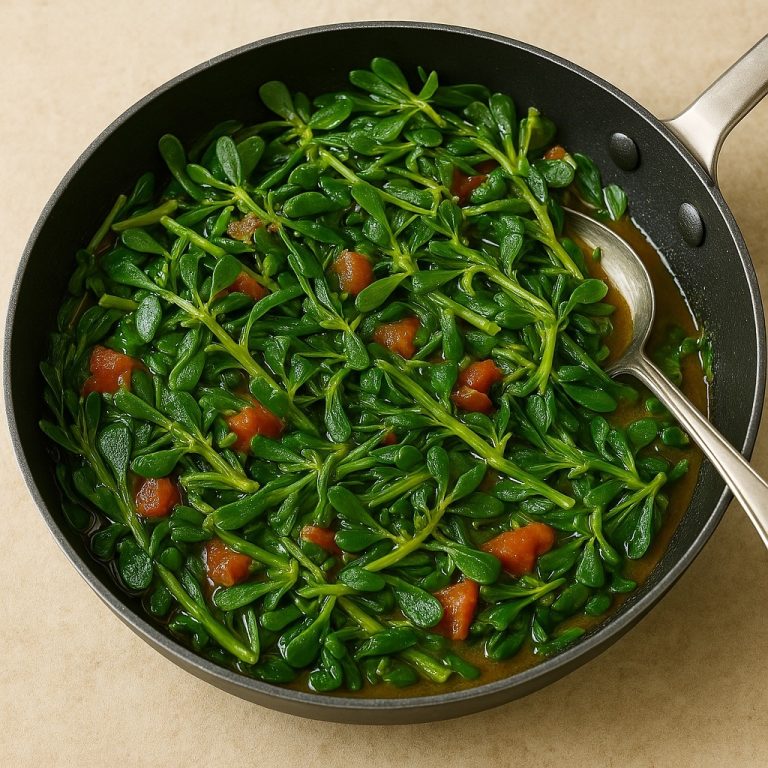ADVERTISEMENT
**Purslane Is Tastier Than Meat! Neighbors from Turkey Taught Me How to Cook Weed**
When it comes to culinary traditions around the world, we often overlook simple, readily available ingredients that can be found growing wild in our backyards. One such overlooked plant is *Purslane* (Portulaca oleracea), a common weed that has long been a staple in many cultures, particularly in the Mediterranean and Middle Eastern regions. I was fortunate enough to learn about the culinary potential of purslane from my Turkish neighbors, and what started as a simple lesson on foraging and cooking has since transformed into a revelation in my kitchen.
As strange as it may sound, purslane is not only a common weed found growing along roadsides, in gardens, and in parks, but it is also a delicious, nutritious plant that can be used in a variety of dishes. In fact, after trying it, I came to the surprising conclusion that purslane is, in many ways, tastier than meat! It has a mild, succulent flavor with a pleasing crisp texture, making it a great substitute for more traditional ingredients.
In this article, I will share the story of how I learned to cook with purslane, the many ways it can be incorporated into dishes, and the health benefits that come with consuming this unique, wild plant. From learning about its nutritional profile to discovering how it can be used in both hot and cold dishes, purslane has proven itself to be much more than just a “weed.”
### **The Journey to Discovering Purslane**
My story with purslane began when I moved into a new neighborhood and befriended a family from Turkey. They were kind, welcoming, and always eager to share their traditions with me. One sunny afternoon, as we sat in their garden enjoying a cup of Turkish tea, my neighbor, Ayşe, casually mentioned that she had just harvested some purslane from her garden to prepare for dinner. Curiosity piqued, I asked her what she was going to make with it.
“Would you like to try it?” she asked with a smile. “I’ll show you how to cook it the way we do in Turkey.”
I agreed, and soon after, we were standing in her garden, picking the thick, succulent leaves of purslane. It was unlike anything I had seen before. Purslane is a low-growing, sprawling plant with small, fleshy, green leaves. Its stems are thick and often reddish, giving the plant a unique appearance. As Ayşe explained, purslane is used in many traditional Turkish dishes, from salads and stews to stuffed dishes and even pilafs.
I was intrigued by her enthusiasm for this humble weed, but I had to admit, I was skeptical about how it could compare to the richness of meat. After all, how could a common weed possibly rival the taste and texture of meat? But I was willing to give it a shot.
### **The First Taste: A Salad with a Difference**
Ayşe began by preparing a simple salad using the fresh purslane leaves, tomatoes, onions, and a drizzle of olive oil, lemon juice, and some herbs. It was a salad unlike any I had ever tasted before. The purslane leaves were tender, with a mild, slightly tangy flavor, and the crunchiness of the stems added a unique texture to the dish. The flavors of the other ingredients complemented the purslane perfectly, making the dish light yet satisfying.
As we sat down to enjoy the salad, Ayşe explained that purslane has been used in Turkish cuisine for centuries. In fact, it is a plant that has been cherished for both its nutritional benefits and its versatility in cooking. Purslane is often incorporated into salads, soups, stews, and even stuffed dishes, much like spinach or other leafy greens.
But what really caught my attention was Ayşe’s statement that purslane was “tastier than meat.” At first, I thought this was just a playful exaggeration, but after tasting the salad, I could understand what she meant. Purslane, with its crisp texture and subtle flavor, had a certain depth that made it satisfying without feeling heavy. The dish was refreshing and energizing, a perfect balance of flavors that left me wanting more.
### **The Nutritional Power of Purslane**
After that first taste, I wanted to learn more about purslane. Why was it so popular in Turkish cuisine? What made it so special? Ayşe shared with me some interesting facts about purslane’s nutritional profile that helped me understand why it has earned its place in the kitchens of so many cultures.
Purslane is not just a tasty green; it’s a powerhouse of nutrients. It contains a wide variety of vitamins, minerals, and antioxidants, making it an incredibly healthy addition to any diet. Here’s a breakdown of its impressive nutritional benefits:
– **Omega-3 Fatty Acids**: Purslane is one of the richest plant sources of omega-3 fatty acids, which are essential for heart health, brain function, and reducing inflammation. The omega-3s in purslane come in the form of alpha-linolenic acid (ALA), which is known to support cardiovascular health.
– **Vitamins and Minerals**: Purslane is packed with essential vitamins and minerals, including Vitamin A, Vitamin C, Vitamin E, and Vitamin K. These vitamins play important roles in maintaining healthy skin, boosting immunity, and supporting bone health. Purslane also contains significant amounts of magnesium, potassium, and iron, all of which contribute to overall health and well-being.
For Complete Cooking STEPS Please Head On Over To Next Page Or Open button (>) and don’t forget to SHARE with your Facebook friends
